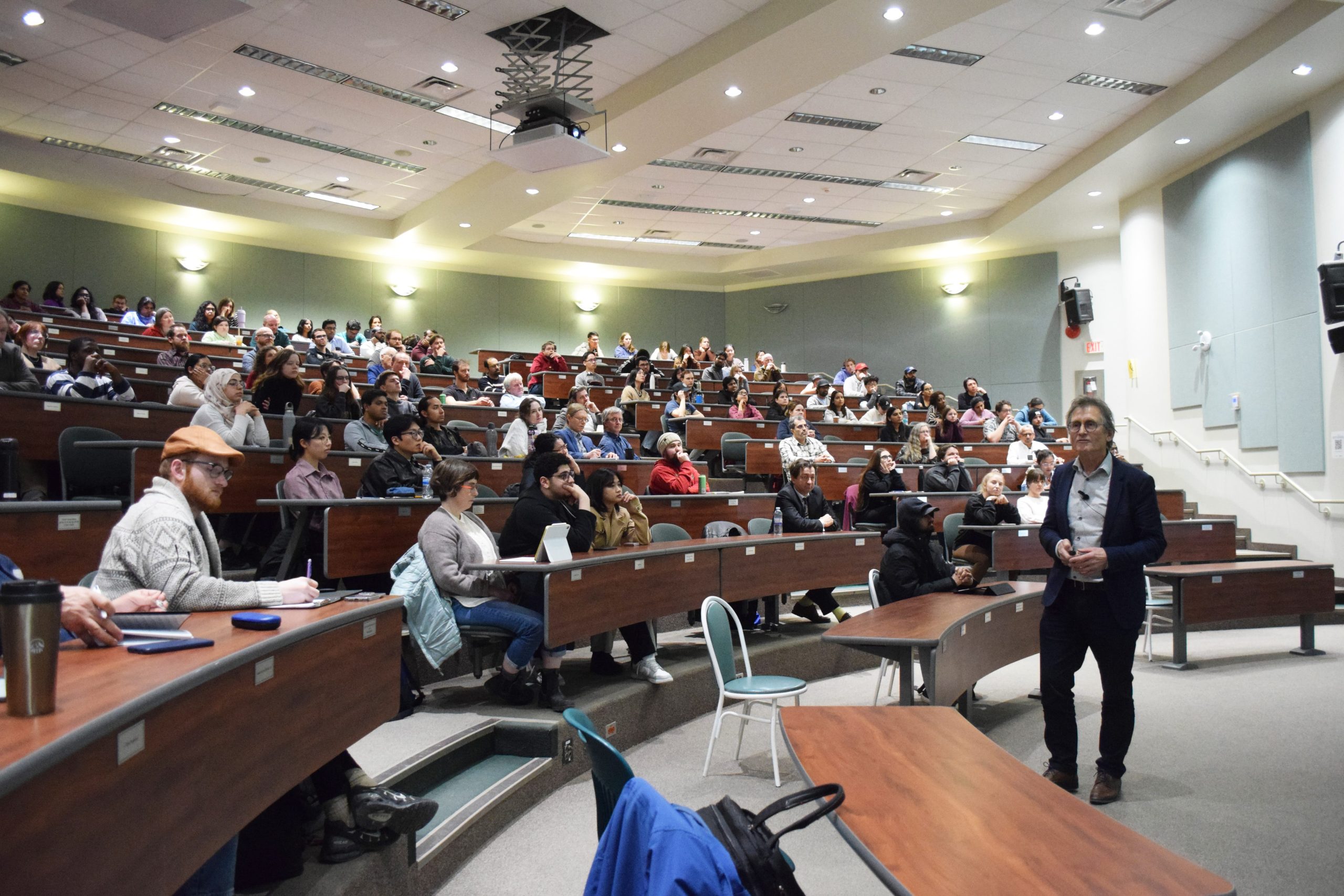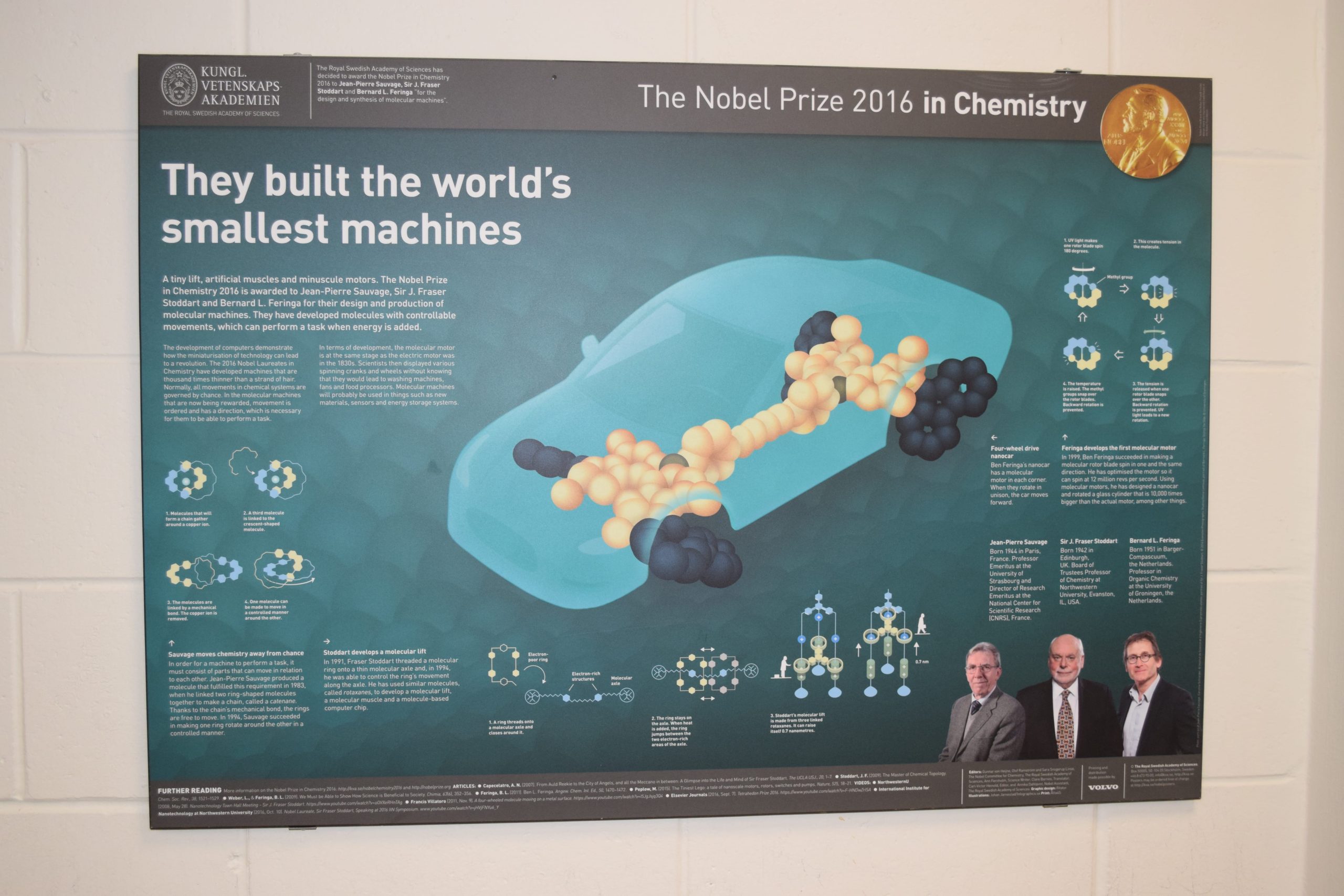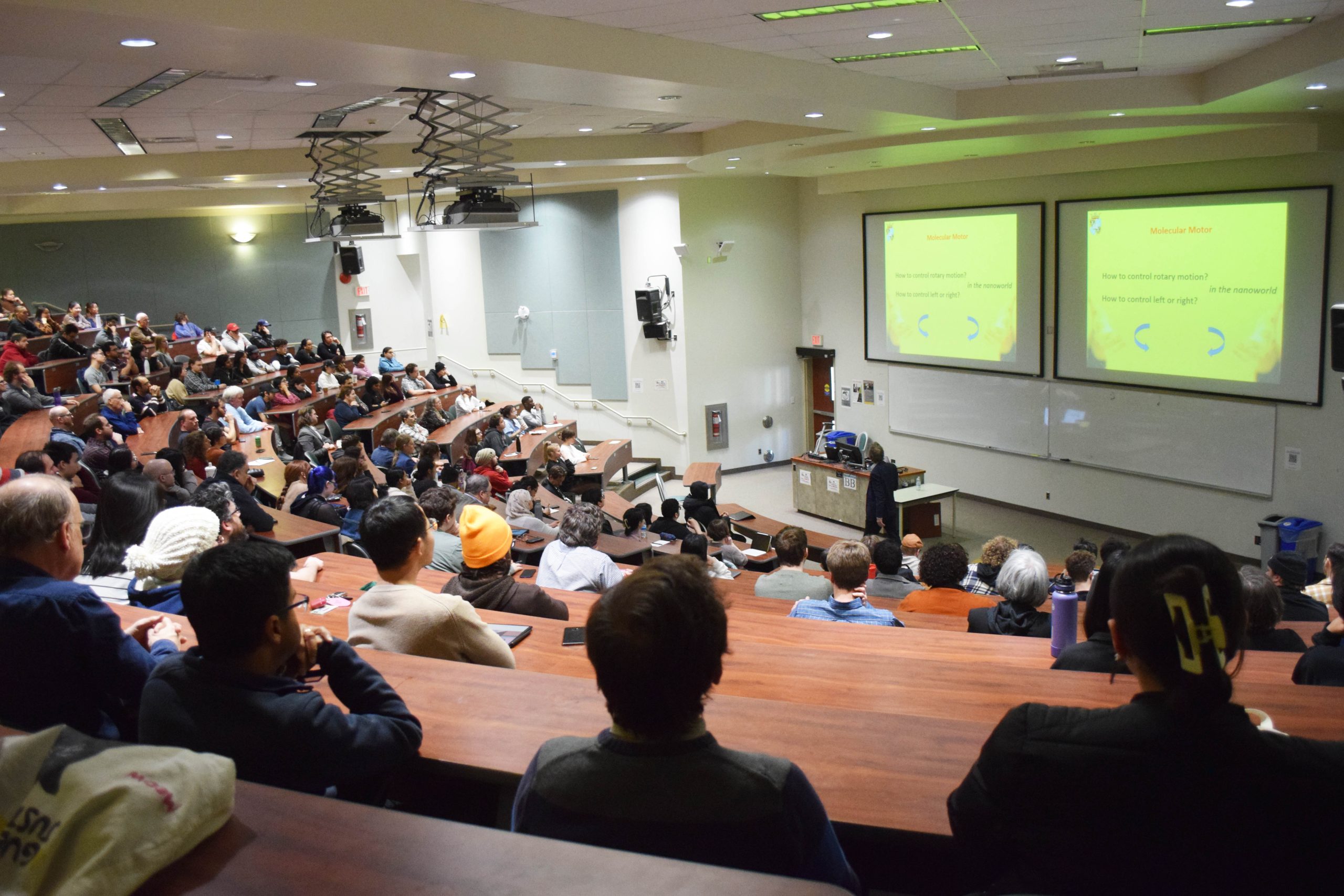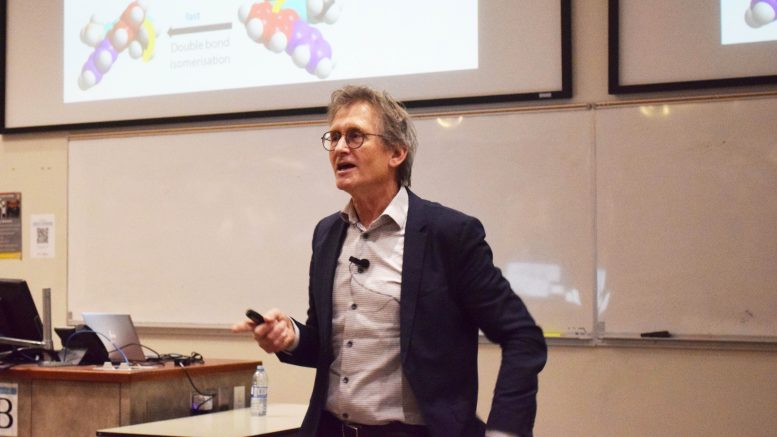Students and staff members at the U of M gathered in the Robert B. Schultz Lecture Theatre on April 3 and 4 to hear from Bernard Feringa, a Nobel laureate and distinguished professor of molecular sciences at the University of Groningen in the Netherlands.
Feringa was jointly awarded the 2016 Nobel prize in chemistry “for the design and synthesis of molecular machines,” along with Sir James Fraser Stoddart and Jean-Pierre Sauvage.
The Nobel laureate provided a general science talk, followed by a specialized science lecture the next day on “the art of building small” — sharing recent work on molecular motors and molecular machines.
Feringa opened the specialized science lecture by recognizing the “fantastic machines” that are in the body, “that make it possible that I can talk to you, that I can see you, that I can wave my hands, that I can walk.”
He stated that motors are responsible for providing dynamic functions in a living system, but called into question the possibility of inducing controlled motion through creating molecular motors and machines — a realm of research that he has been studying for decades.
He argued that a ribosome — the structure inside cells that is responsible for protein synthesis — is “way more sophisticated and complex” than the robot in a car manufacturing plant, which is approximately 100 million times its size.
First molecular motor
In 1999, he constructed the world’s first molecular motor which was light-driven and allowed for continuous rotation in the same direction.
His research group has since optimized the motor to rotate at 12 million revolutions per second in 2014.
“The beauty of light is that you can have the high temporal spatial control,” he stated.
“You can precisely tune where you want to irradiate in three-dimensional space, but also in time. And of course, you can tune the wavelength, the energy you put in there, and it’s non-invasive. You don’t need extra chemicals or whatever. And that’s a big, big advantage for many applications.”
Feringa’s first molecular motor was mechanically constructed to rotate in a certain direction upon exposure to UV light.
“The fundamental questions are how to control rotary motion and how to control left and right,” he stated. “If there’s equal probability going clockwise or counterclockwise you wouldn’t get anywhere. So you have to put in energy and you have to control left and right.”
Feringa stated that his work on molecular machines used a “completely different approach” than Stoddart and Sauvage, who he said used mechanically interlocked molecules.
One of his studies that he highlighted involved 3D printing of shape-morphing materials containing light-driven molecular motors. Based on the presence or absence of UV light, he could reversibly open and close a 3D-printed flower pattern — all visible to the unaided eye.
In the same study, he also had 3D-printed butterfly wings which mimicked a wing flap when exposed to UV light. “It cannot fly yet,” stated the Dutch chemist.
“This is all useless of course at the moment,” he said in reference to those shape-shifting objects, but acknowledged potential applications such as in soft robotics — a subfield that utilizes flexible materials, or in biomedical materials such as artificial muscles.

Feringa has previously referenced several uses for motor-like functions at the molecular level. Photo by Milan Lukes
Feringa’s four-wheel drive nanocar
He also talked about his research group’s construction of the nanocar, a car measuring a few nanometres in length with four rotary motors that can move from conformational changes.
Powered by electrons from a scanning tunnelling microscope, the 2011 Nature publication reveals a “near-ideal linear movement” of six nanometres after ten consecutive voltage pulses. The experiment was conducted in ultrahigh vacuum conditions and at -266 C.
Feringa has previously referenced other uses for motor-like functions at the molecular level, including self-healing materials, smart surfaces and coatings, precision therapeutics and nanoscale energy converters which are “just a small fraction of the systems where fascinating discoveries can be expected.”
“Being a synthetic chemist, we have endless opportunities to build by this chemical synthesis, the new materials in our laboratories with specific properties,” stated Feringa during his 2016 Nobel lecture. “The opportunities are endless.”
Feringa told the Manitoban that he first learned of his interest in chemistry during high school, as the subject was not taught in elementary school.
“Then I got to high school and I had a very inspiring teacher,” he said. “My teacher in chemistry and physics was an amazing person.”
He stated that he chose to major in organic chemistry due to the “diversity of molecules and the materials that you make, all the way from dyes and drugs and all these things.”
Reflecting on his undergraduate studies, Feringa stated that he “enjoyed it very much,” but described some experiments and certain practical courses as tough, adding that statistical thermodynamics is “sometimes a tough course.”

A panel on the wall in the Armes Lecture Building provides information on the research contributions of the 2016 Nobel prize laureates in chemistry. Feringa’s nanocar is visible in the centre of the display. Photo by Milan Lukes
Nobel prize predicted by The Simpsons
Feringa stated that he never imagined he would win a Nobel prize for his research, but stated that sometimes at conferences, people would say that this field might get the prize “because there were so many exciting developments.”
“But then I never thought about it,” citing that he was occupied working and teaching, until an episode of The Simpsons aired.
“In 2011, I got a call from a colleague in America and he said, ‘Ben, you were on American television last night.’ And I said, ‘come on, you’re kidding.’”
Feringa stated that he learned that he was on “prime time American television in The Simpsons” the week before the 2011 Nobel prize winners were announced.
The episode featured Feringa’s name on a Nobel prize betting pool as a potential winner in the field of chemistry.
“And then the next morning I came to the lab and students said to me, ‘Ben, you will get a Nobel prize.’ I said, ‘come on guys.’”
Feringa said that being featured in The Simpsons was “the highest honour” at that time, before eventually winning the Nobel prize five years later.
The 73-year-old professor stated that he still has a large research group, but acknowledged that he will retire at some point.
“You have to be realistic. I will slow down at some point,” he stated.
“But on the other hand, if you ask this to an artist, a musician […] do they say, ‘we will retire?’ We continue, right? And I feel a bit like an artist.”

Feringa advised students to pursue their passion despite the possibility of setbacks. Photo by Milan Lukes
‘Follow your dreams,’ says Feringa
Feringa concluded his lecture by offering advice to students that were in attendance.
“Follow your dreams,” he said.
“Be confident, because yes, we are looking toward new things, going beyond our border, our horizon. It’s about uncertainty, but also about the joy of discovery.”
“Discover your energy. What is your passion? Where do you get a lot of energy? Even if things go wrong, you can still be passionate and say, ‘okay, I will fix it tomorrow or next week,’ or I do it in a different way.”
Feringa described his entry into the field of dynamic molecular motion as an adventure, “where there was hardly anything, no guidelines.
“And with this adventure it was a great joy.”


